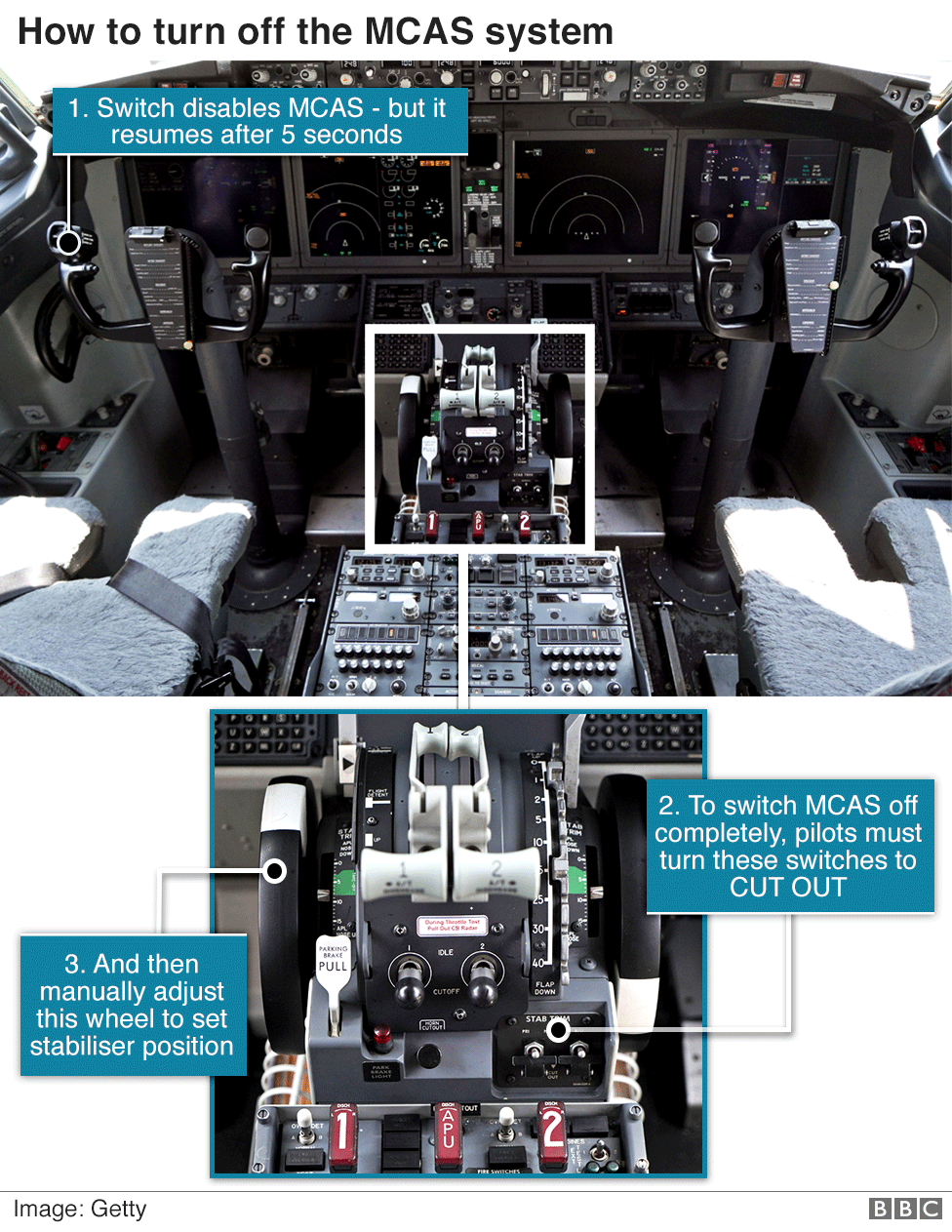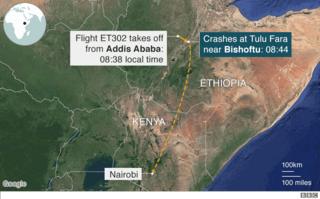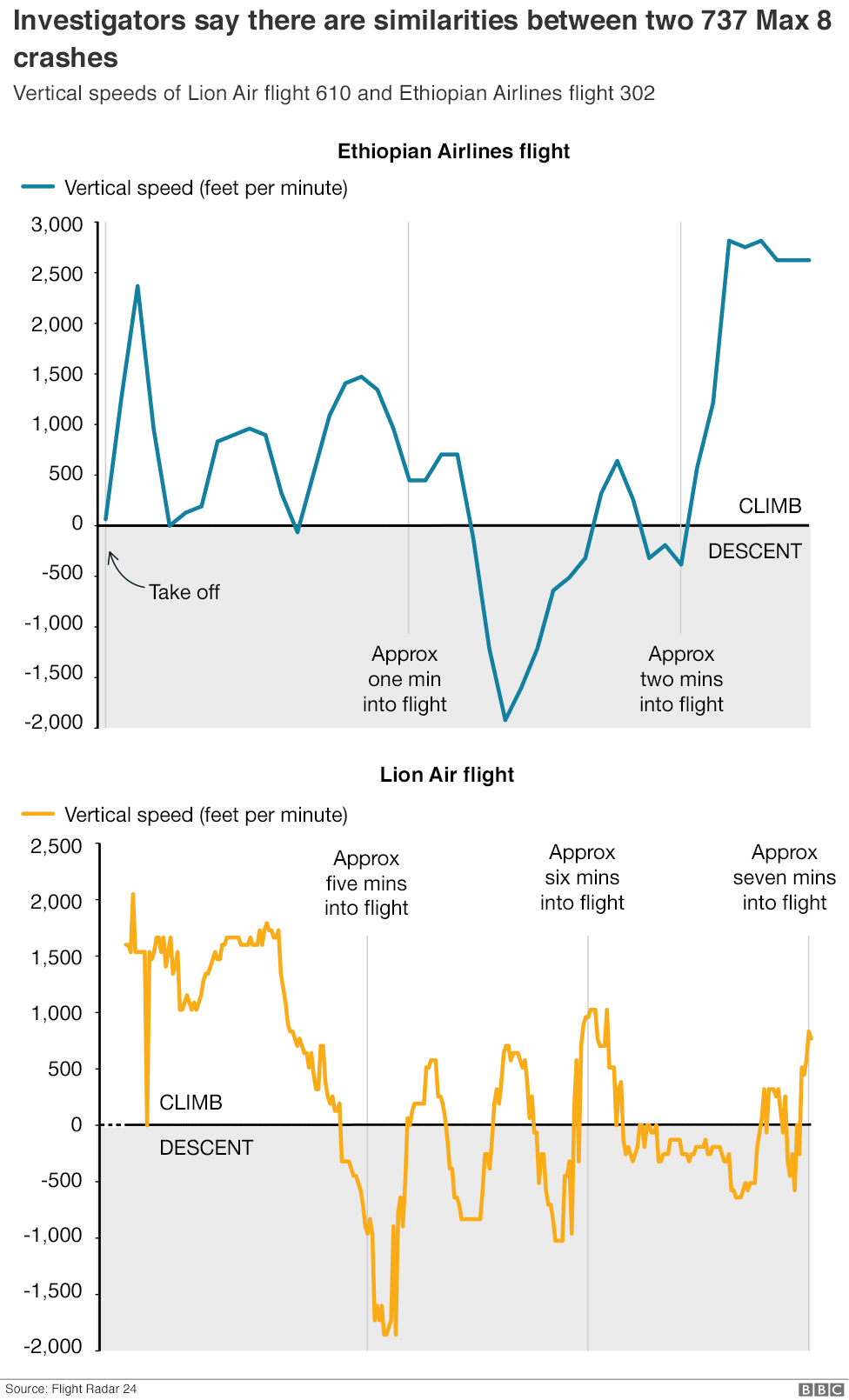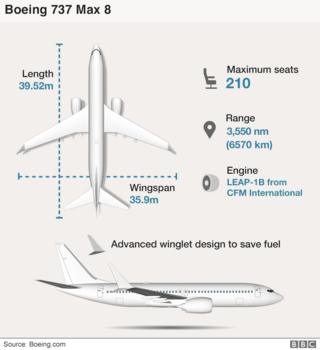Boeing 737 Max: What went wrong?
The pilots of Ethiopian Airlines flight 302 were unable to regain control of their plane despite “repeated” attempts to follow Boeing procedures, an interim report has found.
The Boeing 737 Max aircraft failed to gain altitude and nose-dived into the ground shortly after take off from Addis Ababa on 10 March, with the loss of 157 lives.
The Wall Street Journal, citing unnamed sources, has previously reported that early findings about the cause of the crash were pointing to the computer system, designed to make the handling of aircraft more consistent and lessen the risk of a stall.
Aviation authorities imposed a global flight ban on the 737 Max in March after two fatal crashes in five months.
What is MCAS and why is it under question?
The plane’s safety systems have become the centre of the investigation.
The “Manoeuvring Characteristics Augmentation System” (MCAS) is designed to prevent the plane stalling when making steep turns under manual control.
A stall can happen when the plane flies at too steep an angle. This can reduce the lift generated by the wings, potentially making the plane drop.
To recover from a stall, a pilot would normally push the plane’s nose down.
In the 737 Max, MCAS does this automatically, moving the aircraft back to a “normal” flight position.
The system then repeats the process if the computer detects the plane is still tilted at too-high an angle.
After the Lion Air crash, it was disclosed that the aircraft had experienced problems with a sensor which calculates the angle of flight.
If this sensor gives a false reading, MCAS may activate and push the nose down when nothing is wrong.
And Boeing simulator tests have found that MCAS behaved much more powerfully than expected, repeatedly forcing the aircraft nose down.
In a simulation of the Lion Air flight, test pilots found they had less than 40 seconds to overcome the problem before the plane went into a unrecoverable nose-dive, the New York Times reported.
After the Lion Air crash, Boeing issued guidance to pilots on how to manage MCAS, but a software fix to remedy the problem has been repeatedly delayed.
US regulators and safety experts are now asking how thoroughly the Federal Aviation Authority (FAA) and Boeing vetted the anti-stall system and how well pilots around the world were trained for it when their airlines bought new planes.
A warning light which could have alerted pilots to a problem with the flight sensors was not fitted to either of the planes that crashed.
What happened to the Ethiopian Airlines flight?
Flight ET302 took off from Ethiopian capital Addis Ababa at 08:38 local time (05:38 GMT) on 10 March for a two-hour flight to the Kenyan capital Nairobi.
Six minutes later it crashed 30 miles southeast of the airport, close to the village of Tulu Fara near the town of Bishoftu.
The pilot was named as Senior Capt Yared Getachew who Ethiopian Airlines said had a “commendable performance” with more than 8,000 hours in the air.
He had reported difficulties and asked to return to Addis Ababa, Ethiopian Airlines said.
What evidence could link the two disasters?
Investigators have pointed to similarities in flight data transmitted by the two crashed planes.
Vertical speed readings, which show how fast a plane is going up and down, were erratic and suggest that both sets of pilots were struggling to maintain a steady ascent after take-off.
The FAA, which is investigating the crash alongside the Ethiopian National Transportation Safety Board, has said evidence collected at the site and satellite data showed the two flights behaved “very similarly”.
“The evidence we found on the ground made it even more likely the flight path was very close to Lion Air’s,” said Dan Elwell, acting administrator at the FAA.
This ground evidence is reported to be a piece of wreckage from the tail section which indicates that the horizontal stabiliser was set to point the aircraft nose downwards.
The black box flight recorders – the flight data recorder and cockpit voice recorder – from the aircraft are being examined by investigators in Paris.
What is a Boeing 737 Max?
The Boeing 737 Max fleet of aircraft are the latest in the company’s successful 737 line. The group includes the Max 7, 8, 9 and 10 models.
The aircraft is the fastest-selling in Boeing’s history, with more than 4,500 ordered by 100 different operators globally.
By the end of January, Boeing had delivered 350 of the Max 8 models. They have been in commercial use since 2017.
The Max 8 that crashed in March was one of 30 ordered as part of Ethiopian Airlines’ expansion. It underwent a “rigorous first check maintenance” on 4 February, the airline said.
A small number of Boeing’s Max 9s are also operating. The Max 7 and 10 models, not yet delivered, are due for roll-out in the next few years.
The Boeing 737 first flew in 1967 and was designed as a short-range narrow body airliner.
There have been more than a dozen subsequent models and it remains the best-selling commercial aircraft ever made, with some 10,000 produced.
Source: Read Full Article








